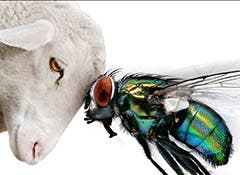Be prepared for preventing blowfly strike
Early prevention of blowfly strike is essential to taking control and reducing health and welfare losses. Be prepared by receiving Blowfly Watch Alerts and checking the Blowfly Risk Forecast and prevent blowfly strike in your flock.
Blowfly Watch Alerts
Our Blowfly Watch email alerts provide sheep farmers with timely, targeted insights into the level of blowfly risk in the farm's area, so you can prevent blowfly strike in your sheep with early preventative treatment.
Blowfly Risk Forecast
Developed in conjunction with NADIS, the blowfly risk forecast uses Met Office weather data to predict the emergence of blowflies and therefore the level of risk relating to the number of animals which might be affected by blowfly strike within 40km2 grids across the UK.
Level of national risk of blowfly strike:
Current risk: Medium
As we progress into Autumn, predicting the remaining blowfly strike risk can be more difficult because of local variations in weather. Blowflies need a temperature above 11°C to lay eggs, but will die following exposure to lower temperatures – especially frost. At this time of year, daytime temperature is often warm enough for strike but night time temperatures can be low enough to kill remaining flies. The sharp change in temperature we saw in September over most of the country means that the risk is now lower – however, some strikes could potentially occur on warmer autumn days going into October.
Be prepared: It is crucial to plan to protect animals against flystrike.
Check the number of strikes reported with our Blowfly Tracker.
Strike first against blowfly
Sources and acknowledgements
The model used to generate these predictions uses Met Office recordings of daily temperatures and rainfall, along with a detailed understanding of fly biology and sheep susceptibility to strike, to forecast the patterns of strike incidence.
The risk level relates to the number of affected sheep expected collectively for all flocks in a region – and the expectation is that most of these sheep would be treated. If sheep were all untreated, incidences would be about 10x higher than the predictions. Each predicted strike level relates to the period from one update to the next.
Risk data provided by Professor Richard Wall BSc, MBA, PhD from the University of Bristol.
CLiK™ EXTRA 65 mg/ml Pour-On Suspension for Sheep contains dicyclanil. POM-VPS
CLiK™ 50 mg/ml Pour-On Suspension for Sheep contains dicyclanil. POM-VPS
CLiKZiN™ 12.5 mg/ml Pour-On Suspension for Sheep contains dicyclanil. POM-VPS
Crovect™ 1.25% w/v Pour-On Solution for Sheep contains cypermethrin (cis:trans/80:20).POM-VPS
Information regarding the side effects, precautions, warnings and contra-indications can be found in product packaging and leaflets; further information can also be found in the Summary of Product Characteristics. Use medicines responsibly. Advice should be sought from the prescriber prior to use. Prescription decisions are for the person issuing the prescription alone.
CLiK EXTRA™, CLiK™, CLiKZiN™, Crovect™, Elanco™ and the diagonal bar™ logo are trademarks of Elanco or its affiliates.

